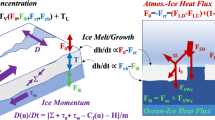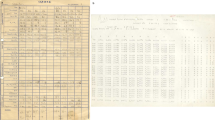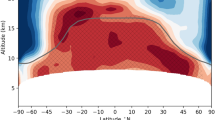Abstract
RECENT theories of the atmospheric circulation ascribe the well-known mid-latitude spring increase in total ozone to the release into the lower stratosphere, during the breakdown of the circumpolar westerlies, of ozone which has been carried to the winter pole by air movements and stored there1–6. The details of this process of accumulation remain speculative, however, until many more ozone observations in the polar night become available on a routine basis. The internationally accepted standard ozone instrument, the Dobson spectrophotometer, normally uses sunlight; useful results can be obtained on the full moon7,8, but this demands an increase in observing skill as well as imposing a serious limitation on continuity.
This is a preview of subscription content, access via your institution
Access options
Subscribe to this journal
Receive 51 print issues and online access
$199.00 per year
only $3.90 per issue
Buy this article
- Purchase on Springer Link
- Instant access to full article PDF
Prices may be subject to local taxes which are calculated during checkout
Similar content being viewed by others
References
Allington, K., Boville, B. W., and Hare, F. K., Tellus, 12, 266 (1960).
Godson, W. L., Quart. J. Roy. Met. Soc., 86, 301 (1960).
Ramanathan, K. R., Indian J. Met. and Geophys., 12, 391 (1961).
Dütsch, H. U., Beiträge z. Phys. der Atmos., 35, 87 (1962).
Goldsmith, P., Discovery, 23, 36 (1962).
Newell, R. E., Quart. J. Roy. Met. Soc., 89, 167 (1963).
Larsen, S. H. H., Geophys. Pub., 21, No. 5 (1959).
MacDowall, J., Roy. Soc. Internat. Geophys. Year Antarctic Exp., 3, 49 (The Royal Society, London, 1962).
Chalonge, D., Sci. Proc. Intern. Assoc. Meteorol., Rome, 1954, 63 (Butterworth, 1956).
Hamilton, R. A., Quart. J. Roy. Met. Soc., 65, 210 (1939).
Larsen, S. H. H., dissertation, Oslo University (1950).
Dobson, G. M. B., Ann. Internat. Geophys. Year, 5, 46 (1958); Proc. Roy. Soc., A, 110, 660 (1926).
Redman, R. O., and Yates, G. G., in Astronomical Photoelectric Photometry, edit. by Wood, F. B. (Washington, D.C., 1953).
Vigroux, E., Ann. de Phys., Ser. 12, 8, 709 (1953).
Cabannes, J., J. Phys. Radium, 7, 260 (1929).
Ramanathan, K. R., Rep. to IUGG/WMO Ozone Symp., Arosa, 1961 (unpublished).
Dütsch, H. U., Final Rep. Ozone and General Circ. in Stratosphere, Contract A.F.61 (514)-905 (1959).
Author information
Authors and Affiliations
Rights and permissions
About this article
Cite this article
WARDLE, D., WALSHAW, C. & WORMELL, T. A New Instrument for Atmospheric Ozone. Nature 199, 1177–1178 (1963). https://doi.org/10.1038/1991177b0
Issue Date:
DOI: https://doi.org/10.1038/1991177b0
Comments
By submitting a comment you agree to abide by our Terms and Community Guidelines. If you find something abusive or that does not comply with our terms or guidelines please flag it as inappropriate.



